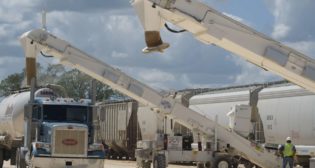
Rail traffic inching back toward record levels
Written by William C. Vantuono, Editor-in-ChiefThe Association of American Railroads Thursday reported gains for September rail traffic compared with the same month last year, with U.S. railroads originating 1,195,671 carloads, up 1.1%, and 949,606 trailers and containers, up 2.3%. But more significant, weekly carloadings hit a three-year high, and intermodal volume reached a four-year high—this week’s U.S. carload volume is highest since Week 45 of 2008, and intermodal volume is the highest since Week 39 of 2007. As well, through the third quarter of 2011, U.S. carloads are at 87% of the levels they were at this point in 2006, the highest year on record for U.S. rail traffic. Intermodal volume in the first nine months of 2011 is 96% of what it was in the peak year of 2006.
In September 2011, 13 of the 20 carload commodity categories saw increases on U.S. railroads compared with September 2010. The largest gains were: coal, up 6,356 carloads or 1.2%; primary metal products, up 5,272 carloads or 14.4%, and motor vehicles and parts, up 4,445 carloads or 8.2%. In%age terms, the biggest increase in U.S. carloads in September was in petroleum and petroleum products, up 16.1%. Compared with September 2010, grain carloads in September 2011 were down 16,849 carloads or 18.2%, continuing a three month-long slide.
“Carloads have been closely tracking last year’s levels for six months, and intermodal continues to grow, though more moderately than earlier this year,” said AAR Senior Vice President John T. Gray. “Rail traffic is consistent with an economy that is probably still growing, but far more slowly than any of us would want.”
AAR today reported gains in weekly rail traffic, with U.S. railroads originating 312,170 carloads for the week ending Oct. 1, 2011, up 4.7% compared with the same week last year. Intermodal volume for the week totaled 250,864 trailers and containers, up 4.4% compared with the same week last year.
Fourteen of the 20 carload commodity groups posted increases from the comparable week in 2010, including: metallic ores, up 24.9%; metals and products, up 17.5%, and nonmetallic minerals, up 16.6%. Groups showing a decrease in weekly traffic included: farm products excluding grains, down 21.4%; grain, down 17%, and waste and nonferrous scrap, down 11.2%.
Weekly carload volume on Eastern railroads was up 5.8% compared with the same week last year. In the West, weekly carload volume was up 4% compared with the same week in 2010.
For the first 39 weeks of 2011, U.S. railroads reported cumulative volume of 11,329,150 carloads, up 1.8% from the same point last year, and 8,881,226 trailers and containers, up 5.4% from last year.
Canadian railroads reported 81,837 carloads for the week, up 3.7% compared with the same week last year, and 51,755 trailers and containers, down 0.3% compared with 2010. For the first 39 weeks of 2011, Canadian railroads reported cumulative volume of 2,920,761 carloads, up 2.8% from the same point last year, and 1,871,921 trailers and containers, up 1.7% from last year.
Mexican railroads reported 14,376 carloads for the week, up 5% compared with the same week last year, and 10,407 trailers and containers, up 22.8%. Cumulative volume on Mexican railroads for the first 39 weeks of 2011 was 557,836 carloads, up 4.5% compared with the same point last year, and 324,279 trailers and containers, up 24.6%.
Combined North American rail volume for the first 39 weeks of 2011 on 13 reporting U.S., Canadian and Mexican railroads totaled 14,807,747 carloads, up 2.1% compared with the same point last year, and 11,077,426 trailers and containers, up 5.3% compared with last year. The combined weekly intermodal volume of 313,026 trailers and containers, up 4.1% over last year, is a new record.
Rail employment continues to make gains, with 1,191 jobs added in August 2011, the latest month for employment data, bringing total Class I freight railroad employment to 160,107. During September, railcar owners brought 11,087 cars out of storage, leaving roughly 17.1% of the North American rail car fleet remaining in storage.

![“This record growth [in fiscal year 2024’s third quarter] is a direct result of our innovative logistic solutions during supply chain disruptions as shippers focus on diversifying their trade lanes,” Port NOLA President and CEO and New Orleans Public Belt (NOPB) CEO Brandy D. Christian said during a May 2 announcement (Port NOLA Photograph)](https://www.railwayage.com/wp-content/uploads/2024/05/portnola-315x168.png)

